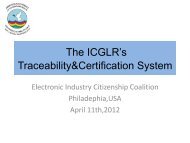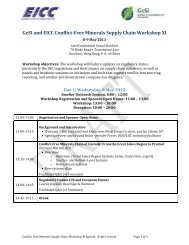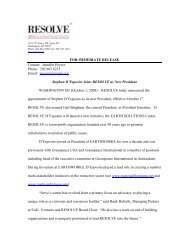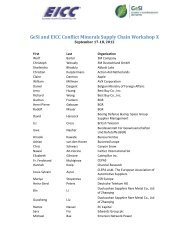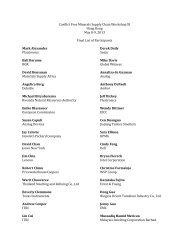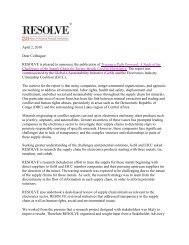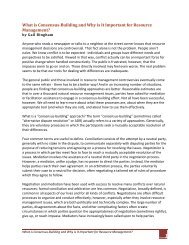Toward SuSTainabiliTy: The roleS and limiTaTionS of ... - Resolve
Toward SuSTainabiliTy: The roleS and limiTaTionS of ... - Resolve
Toward SuSTainabiliTy: The roleS and limiTaTionS of ... - Resolve
Create successful ePaper yourself
Turn your PDF publications into a flip-book with our unique Google optimized e-Paper software.
Chapter 1: Setting the Context 12with the st<strong>and</strong>ard. <strong>The</strong> decision about whetherthe st<strong>and</strong>ard should set performance requirementsor outline management practices is themost obvious example <strong>of</strong> two different structures,but structural decisions can also be madeabout scoring mechanisms, critical criteria, <strong>and</strong>pass/fail levels. Options range from managementsystem st<strong>and</strong>ards to threshold st<strong>and</strong>ards<strong>and</strong> from continuous improvement models to“traffic light” systems. A threshold st<strong>and</strong>ard, forexample, requires the certified entity to meet all<strong>of</strong> the critical or m<strong>and</strong>atory criteria as well as aset percentage <strong>of</strong> the other criteria. <strong>The</strong> MSC hassuch a st<strong>and</strong>ard; it requires a threshold score <strong>of</strong>80 out <strong>of</strong> 100 for each <strong>of</strong> its three principles. <strong>The</strong>Common Code for the C<strong>of</strong>fee Community (4C)scheme has a traffic light system in which “red”criteria must be met <strong>and</strong> an average “yellow”must be achieved overall. FLO has a continuousimprovement model in which producer groupsmust meet entry requirements at the outset <strong>and</strong>then additional criteria over time.Assuring ComplianceOnce a st<strong>and</strong>ard has been defined <strong>and</strong> is beingapplied by participating enterprises, the marketusually requires some form <strong>of</strong> assurance that theenterprise is actually meeting the requirementsin the st<strong>and</strong>ard. For systems with market-facinglabels, assurance also serves to support consumerconfidence in the legitimacy <strong>of</strong> the label.This assurance <strong>of</strong>ten takes the form <strong>of</strong> a qualifiedauditor visiting the enterprise <strong>and</strong> assessing theircompliance with the st<strong>and</strong>ard by looking at boththe practices <strong>and</strong> documentation <strong>of</strong> the enterprise.<strong>The</strong> audit can range from a simple checklistapproach to a more in-depth assessment thatincludes interviews with management, workers,<strong>and</strong> local community members.<strong>The</strong> assurance process can take a number <strong>of</strong>forms, including verification, certification, <strong>and</strong>accreditation, each with varying levels <strong>of</strong> independence<strong>and</strong> rigor. Verification is the act <strong>of</strong> assessingcompliance with a st<strong>and</strong>ard <strong>and</strong> is usually carriedout by assessors or auditors. Certification is whena formal decision on compliance is made basedon the results <strong>of</strong> an auditor’s report. Accreditationis then another layer <strong>of</strong> assurance consisting <strong>of</strong> anassessment <strong>of</strong> the competence <strong>of</strong> the certificationbody to determine compliance with the st<strong>and</strong>ard.No matter the form used, there is a typology<strong>of</strong> assurance models ranging from less to moreformal <strong>and</strong> from less to more independent, asfollows:▪ First-party assessment—a self-assessment▪ Second-party assessment—an assessmentby an interested party (e.g., a producer group,trade association, or buyer)▪ Third-party assessment—an independentanalysis conducted by a party not related tothe entity being assessed<strong>The</strong>se models can also be combined, to thebenefit <strong>of</strong> both accessibility <strong>and</strong> rigor. Group certificationmodels, for example, which are prevalentin agriculture, combine a second-party internalaudit <strong>and</strong> a peer-review process among anorganized group <strong>of</strong> producers with a third-partyindependent assessment <strong>of</strong> the group’s managementsystem. This approach enables small-scaleproducers to enter into certification through aproducer group, thus sharing the costs <strong>of</strong> externalverification. St<strong>and</strong>ards systems are now looking atinnovative ways to combine self-assessment withsecond- <strong>and</strong> third-party audits to streamline thecertification process.<strong>The</strong> systems addressed in depth in this reporttypically use third-party assessments, though theyhave the capability to integrate this with groupcertification models for small <strong>and</strong> medium-sizedenterprises.Auditor Competence<strong>The</strong> role <strong>of</strong> auditors or assessors in a st<strong>and</strong>ardssystem is critical (Courville, 2004; Morimoto,Ash, & Hope, 2005; Power, 2003). <strong>The</strong>se arethe individuals responsible for assessing compliancewith the st<strong>and</strong>ard <strong>and</strong>, as such, need tobe competent at their jobs. Auditor competencederives from a combination <strong>of</strong> skills, knowledge,<strong>and</strong> personal attributes. St<strong>and</strong>ards systems takedifferent approaches to auditor oversight, includingthe training <strong>and</strong> pr<strong>of</strong>essional development <strong>of</strong><strong>Toward</strong> Sustainability: <strong>The</strong> Roles <strong>and</strong> Limitations <strong>of</strong> Certification



